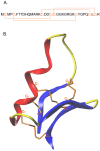Chlorotoxin: a helpful natural scorpion peptide to diagnose glioma and fight tumor invasion
- PMID: 25826056
- PMCID: PMC4417956
- DOI: 10.3390/toxins7041079
Chlorotoxin: a helpful natural scorpion peptide to diagnose glioma and fight tumor invasion
Abstract
Chlorotoxin is a small 36 amino-acid peptide identified from the venom of the scorpion Leiurus quinquestriatus. Initially, chlorotoxin was used as a pharmacological tool to characterize chloride channels. While studying glioma-specific chloride currents, it was soon discovered that chlorotoxin possesses targeting properties towards cancer cells including glioma, melanoma, small cell lung carcinoma, neuroblastoma and medulloblastoma. The investigation of the mechanism of action of chlorotoxin has been challenging because its cell surface receptor target remains under questioning since two other receptors have been claimed besides chloride channels. Efforts on chlorotoxin-based applications focused on producing analogues helpful for glioma diagnosis, imaging and treatment. These efforts are welcome since gliomas are very aggressive brain cancers, close to impossible to cure with the current therapeutic arsenal. Among all the chlorotoxin-based strategies, the most promising one to enhance patient mean survival time appears to be the use of chlorotoxin as a targeting agent for the delivery of anti-tumor agents. Finally, the discovery of chlorotoxin has led to the screening of other scorpion venoms to identify chlorotoxin-like peptides. So far several new candidates have been identified. Only detailed research and clinical investigations will tell us if they share the same anti-tumor potential as chlorotoxin.
Figures


Similar articles
-
[Chlorotoxin and related peptides are short insect toxins from scorpion venom].Bioorg Khim. 2014 Jul-Aug;40(4):387-98. doi: 10.1134/s1068162014040013. Bioorg Khim. 2014. PMID: 25898748 Review. Russian.
-
Use of chlorotoxin for targeting of primary brain tumors.Cancer Res. 1998 Nov 1;58(21):4871-9. Cancer Res. 1998. PMID: 9809993
-
Chlorotoxin-A Multimodal Imaging Platform for Targeting Glioma Tumors.Toxins (Basel). 2018 Nov 26;10(12):496. doi: 10.3390/toxins10120496. Toxins (Basel). 2018. PMID: 30486274 Free PMC article. Review.
-
Chlorotoxin, a scorpion-derived peptide, specifically binds to gliomas and tumors of neuroectodermal origin.Glia. 2002 Aug;39(2):162-73. doi: 10.1002/glia.10083. Glia. 2002. PMID: 12112367
-
Chlorotoxin: Structure, activity, and potential uses in cancer therapy.Biopolymers. 2016 Jan;106(1):25-36. doi: 10.1002/bip.22748. Biopolymers. 2016. PMID: 26418522 Review.
Cited by
-
Advances in immunotherapy for glioblastoma multiforme.Front Immunol. 2022 Oct 12;13:944452. doi: 10.3389/fimmu.2022.944452. eCollection 2022. Front Immunol. 2022. PMID: 36311781 Free PMC article. Review.
-
Voltage-Gated K+/Na+ Channels and Scorpion Venom Toxins in Cancer.Front Pharmacol. 2020 Jun 18;11:913. doi: 10.3389/fphar.2020.00913. eCollection 2020. Front Pharmacol. 2020. PMID: 32655396 Free PMC article. Review.
-
Forging the Frontiers of Image-Guided Neurosurgery-The Emerging Uses of Theranostics in Neurosurgical Oncology.Front Bioeng Biotechnol. 2022 Jul 12;10:857093. doi: 10.3389/fbioe.2022.857093. eCollection 2022. Front Bioeng Biotechnol. 2022. PMID: 35903794 Free PMC article. No abstract available.
-
Subproteome of Lachesis muta rhombeata venom and preliminary studies on LmrSP-4, a novel snake venom serine proteinase.J Venom Anim Toxins Incl Trop Dis. 2019 Apr 15;25:e147018. doi: 10.1590/1678-9199-JVATITD-1470-18. eCollection 2019. J Venom Anim Toxins Incl Trop Dis. 2019. PMID: 31131000 Free PMC article.
-
The Significant Therapeutic Effects of Chinese Scorpion: Modern Scientific Exploration of Ion Channels.Pharmaceuticals (Basel). 2024 Dec 22;17(12):1735. doi: 10.3390/ph17121735. Pharmaceuticals (Basel). 2024. PMID: 39770577 Free PMC article. Review.
References
Publication types
MeSH terms
Substances
LinkOut - more resources
Full Text Sources
Other Literature Sources
Medical

